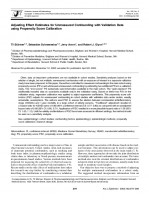Download
| File Size | 119.2 KiB |
|---|---|
| Date | August 31, 2013 |
| Downloads | 0 |
Often, data on important confounders are not available in cohort studies. Sensitivity analyses based on the relation of single, but not multiple, unmeasured confounders with an exposure of interest in a separate validation study have been proposed. In this paper, the authors controlled for measured confounding in the main cohort using propensity scores (PS’s) and addressed unmeasured confounding by estimating two additional PS’s in a validation study. The ‘‘error-prone’’ PS exclusively used information available in the main cohort. The ‘‘gold standard’’ PS additionally included data on covariates available only in the validation study. Based on these two PS’s in the validation study, regression calibration was applied to adjust regression coefficients. This propensity score cali- bration (PSC) adjusts for unmeasured confounding in cohort studies with validation data under certain, usually untestable, assumptions. The authors used PSC to assess the relation between nonsteroidal antiinflammatory drugs (NSAIDs) and 1-year mortality in a large cohort of elderly persons. ‘‘Traditional’’ adjustment resulted in a hazard ratio for NSAID users of 0.80 (95% confidence interval (CI): 0.77, 0.83) as compared with an unadjusted hazard ratio of 0.68 (95% CI: 0.66, 0.71). Application of PSC resulted in a more plausible hazard ratio of 1.06 (95% CI: 1.00, 1.12). Until the validity and limitations of PSC have been assessed in different settings, the method should be seen as a sensitivity analysis.
KEYWORDS: bias (epidemiology); cohort studies; confounding factors (epidemiology); epidemiologic methods; propensity score calibration; research design
KEYWORDS: bias (epidemiology); cohort studies; confounding factors (epidemiology); epidemiologic methods; propensity score calibration; research design



